Jadual Kandungan
Selangor Eurasian Association Clubhouse (1940-2013)
Dirujuk oleh
Perihal
“In 1940, the Selangor and Federal Territory Eurasian Association (SAFTEA’s earlier incarnation) was offered a licence to use a piece of land (of about 4 acres) in Maxwell Road. We could not accept the land at the time, as we could not afford to build a clubhouse then. After the war, the association wanted to accept the land, but it was then unavailable, as the military was using it. SEA was informed that the land would be available in 1955; according to records however, the association did not claim the land after this time. … We moved to the clubhouse at 167, Jalan Pudu in 1953, and have been here for 60 years; the area now occupied by SAFTEA is 0.64 acres.” (Selangor & Federal Territory Eurasian Association (SAFTEA), September 2013: |Saftea News, ISSUE 1 / 2013 Jan - Sept, m.s. 1-3).
Kronologi
1940-01-05: Tapak Cadangan

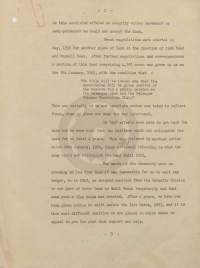
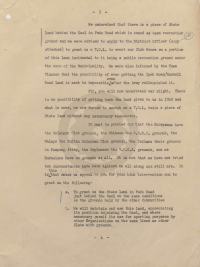
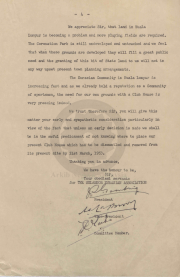
Pada asalnya, tapak yang telah dicadangkan bagi premis persatuan ini pada 5 Januari 1940 ialah di persimpangan Jalan Ipoh dan Jalan Maxwell, namun prosesnya tertunda akibat Perang Dunia ke-2. Setelah perang tamat, pada tahun 1947 pihak persatuan berusaha mendapatkan tanah tersebut, namun ianya masih diduduki tentera British sehingga 1955. Persatuan terpaksa menumpang di tanah Catholic Mission di Bukit Nanas, sehingga menerima notis untuk berpindah sebelum 31 Mac 1953. Maka pada Januari 1953, mereka memohon pendudukan sementara (T.O.L.) di tanah rizab Penjara Pudu ini: “In June 1934, application was made by this Association for land at the junction of Kia Peng Road and Circular Road. After lengthy correspondence in January 1936 a T.O.L. was granted us over an area of 11 1/2 acres with the condition - “A T.O.L. not only expires at the end of the year but it is also liable to cancellation by the Government at any time without compensation.” As this condition offered no security either permanent or semi-permanent we could not accept the land. Fresh negotiations were started in May, 1936 for another piece of land at the junction of Ipoh Road and Maxwell Road. After further negotiations and correspondence a portion of this land comprising 4,380 acres was given to us on the 5th January, 1940, with the condition that - “No title will be issued and that the Association will be given control of the reserve for a public purpose as the Selangor Club and the Selangor Chinese Recreation Club.” This was suitable to us and immediate action was taken to collect funds, draw up plans etc when the war intervened. In 1947 efforts were made to get back the land but we were told that the Military could not relinquish the land for at least 4 years. This was followed by another letter dated 20th January, 1950, (copy attached) informing us that the Army could not relinquish the land until 1955. The needs of the Community were so pressing at the time that it was impossible for us to wait any longer, so in 1948, we secured sanction from the Catholic Mission to use part of their land in Bukit Nanas temporarily and that same year a Club House was erected. After 4 years, we have now been given notice to shift before the 31st March, 1953, and it is this most difficult position we are placed in which makes us appeal to you for your kind support and help. We understand that there is a piece of State land behind the Gaol in Pudu Road which is zoned as open recreation ground and we were advised to apply to the District Officer (copy attached) to grant us a T.O.L. to erect our Club House on a portion of this land incidental to it being a public recreation ground under the care of the Municipality. We were also informed by the Town Planner that the possibility of ever getting the Ipoh Road/Maxwell Road land is next to impossible even after the Army relinquished it. … It is this that makes us appeal to you for your kind intervention and to grant us the following - a. To grant us the State land in Pudu Road just behind the Gaol on the same conditions as the grounds held by the other Communities; b. We will maintain and use this land, appreciating its position adjoining the Gaol, and where necessary permit its use for sporting purposes by other Organisations on the same lines as other Clubs with grounds. - THE SELANGOR EURASIAN ASSOCIATION, January 1953.” (PEJABAT SETIAUSAHA KERAJAAN NEGERI SELANGOR, 31/01/1953: |"APPLICATION FROM SELANGOR EURASIAN ASSOCIATION FOR STATE LAND IN PUDU, BEHIND THE PUDU GAOL, KUALA LUMPUR").
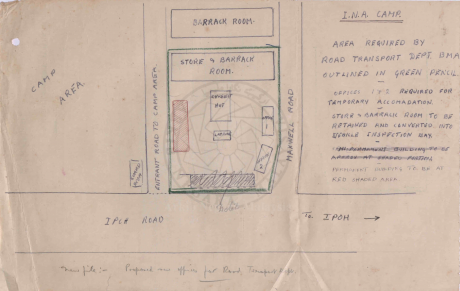

Peta lokasi sekitar tapak asal yang dicadangkan bagi premis SAFTEA (bersama 2 persatuan lain) di lot 9 sec.48, persimpangan Jalan Ipoh dan Jalan Maxwell pada 5 Januari 1940. Namun prosesnya tertunda akibat Perang Dunia ke-2:-
Kiri: Tapak ini kemudiannya dicadangkan bagi premis P.W.D. pada 1946 tetapi tidak diluluskan dan kekal sebagai rizab persatuan: “Rough sketch of the area required by the Rd. Transport Dept. … I.N.A. Camp: Area required by Road Transport Dept. BMA outlined in green pencil. Offices 1 & 2 required for temporay accoma(o)dation. Store & Barrack room to be retained and converted into vehicle inspection bay. Permanent building to be at red shaded area. … The Chairman submits correspondence from the S.C.A.O.,Selangor, on the subject of the new offices proposed for the Road Transport Department on lot 9 sec.48, at the junction of Maxwell and Ipoh Roads. He points out that the site chosen is at the old I.N.A. Camp at Ipoh Road. On referring the matter to the Town Planning Department, he is informed that this site is zoned for special purposes and was approved by Government late in 1940 as an open space for recreational purposes and allotted to three clubs, namely the Selangor Eurasian Association, The Trade School, and the Java Peranakan Club. A preliminary survey was commenced but left incomplete due to the outbreak of war. Alternative sites suggested by the Town Planning Department are also put before the Board. After discussion, the Board does not agree to the proposal to utilise this site for new offices for the Road Transport Department.” (British Military Administration, 11/02/1946: |"Proposed new offices for Road Transport Department").
Kanan: Peta lokasi tapak tersebut kini, di persimpangan Jalan Sultan Ismail / Tun Razak dan Jalan Ipoh (Sultan Azlan Shah), di sekitar Bangunan PERKIM.
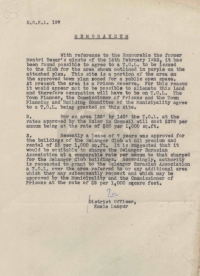


Pada 14 Februari 1953, permohonan Selangor Eurasian Association untuk menduduki tanah rizab sebelah selatan Penjara Pudu itu telah diluluskan oleh Menteri Besar ketika itu, Raja Uda Raja Muhammad: “With reference to the Honourable the former Mentri Besar's minute of the 14th February 1953, it has been found possible to agree to a T.O.L. to be issued to the Club for the area shown outlined in purple on the attached plan. This site is a portion of the area on the approved town plan zoned for a public open space. At present the area is a Prison Reserve. For this reason it would appear not to be possible to alienate this land and therefore occupation will have to be on T.O.L. The Town Planner, the Commissioner of Prisons and the Town Planning and Building Committee of the Municipality agree to a T.O.L. being granted on this site. … - District Officer, Kuala Lumpur.”
(PEJABAT SETIAUSAHA KERAJAAN NEGERI SELANGOR, 31/01/1953: |"APPLICATION FROM SELANGOR EURASIAN ASSOCIATION FOR STATE LAND IN PUDU, BEHIND THE PUDU GAOL, KUALA LUMPUR").
1953-03: Tanah Rizab Penjara Pudu
Sekitar Mac 1953, Selangor Eurasian Association dianugerahi lesen pendudukan sementara (T.O.L.) di sebahagian tanah rizab Penjara Pudu di sebelah selatannya. Sebuah clubhouse telah didirikan di lokasi tersebut, dan ianya kekal sehingga selepas perobohan keseluruhan Penjara Pudu, iaitu pada 8 Oktober 2013:-
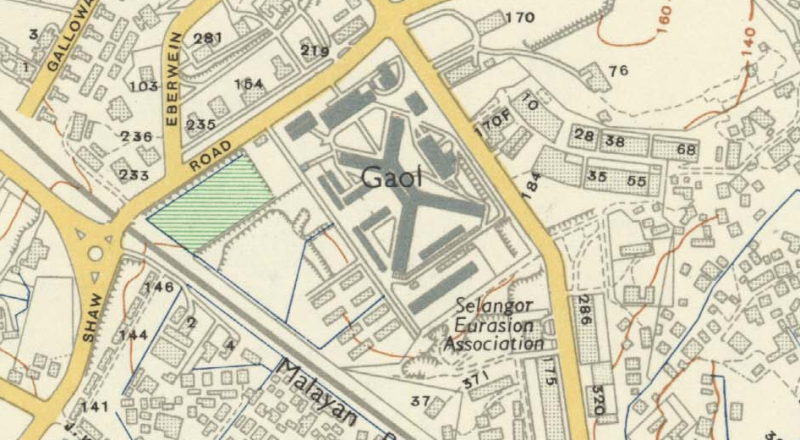
Peta lokasi Penjara Pudu, 1957. “Malaysia, Malaya, Kuala Lumpur, 1957, 1:380 160” (Surveyor General, Malaya @ The Australian National University, 1957: |"Malaysia, Malaya, Kuala Lumpur, 1957, 1:380 160").
Kelihatan di dalam peta di atas, “clubhouse” Selangor Eurasian Assocation (kini Selangor and Federal Territory Eurasian Association - SAFTEA) di tanah rizab Penjara Pudu di sebelah selatannya seluas 0.64 ekar.
2013-10-08: Pemindahan SAFTEA Clubhouse
Sejak Oktober 1953, Selangor & Federal Territory Eurasian Association (SAFTEA) Clubhouse terletak di tanah rizab Penjara Pudu di sebelah tenggara, beralamat di 167, Jalan Pudu. Pada asalnya ia adalah petempatan sementara sahaja, oleh kerana tanah yang diberikan di Jalan Maxwell (kini Jalan Sultan Ismail) sedang digunakan oleh pihak tentera ketika itu. Pada tahun 1981 pihak DBKL pernah membenarkan pendudukannya secara rasmi pada 1981, namun ia tidak diketahui ketika permohonan lesen pendudukan sementara (TOL) dibuat pada tahun 1985, lalu tidak diluluskan. Hal ini hanya diketahui oleh pihak SAFTEA pada tahun 2012 (kemungkinan ketika UDA sedang meneruskan perobohan seluruh kompleks Penjara Pudu). Setelah siri mesyuarat dengan pihak kerajaan, serta tindakan guaman terhadap UDA, akhirnya pihak SAFTEA dianugerahi sebidang tanah di Bangsar Utama, dan mereka perlu berpindah ke sana pada 8 Oktober 2013:-
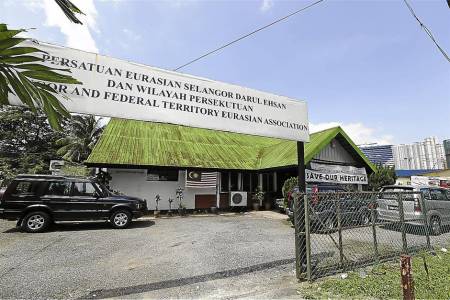
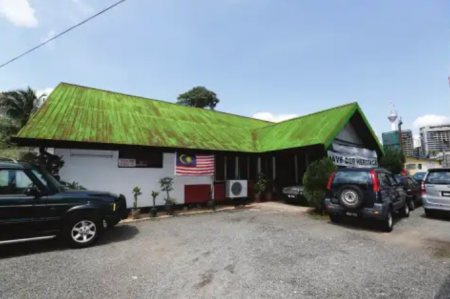
The Saftea Clubhouse @ 167, Jalan Pudu (Gambar September 2013):-
Kiri: (YVONNE T. NATHAN @ The Star, 30 Sep 2013: |"Saftea members sad at prospect of leaving 60-year-old Pudu club").
Kanan: (Selangor & Federal Territory Eurasian Association (SAFTEA), September 2013: |Saftea News, ISSUE 1 / 2013 Jan - Sept, m.s. 1).
“In 1940, the Selangor Eurasian Association (SAFTEA’s earlier incarnation) was offered a licence to use a piece of land (of about 4 acres) in Maxwell Road. We could not accept the land at the time, as we could not afford to build a clubhouse then. After the war, the association wanted to accept the land, but it was then unavailable, as the military was using it. SEA was informed that the land would be available in 1955; according to records however, the association did not claim the land after this time. … We moved to the clubhouse at 167, Jalan Pudu in 1953, and have been here for 60 years; the area now occupied by SAFTEA is 0.64 acres. Thanks to the Government Valuers (JUPEM) who came to the site on 9 September, 2012 we know that our boundary reaches until the edge of the yellow building outside. … It was said that we could never own this plot, as it belongs to the jail reserve. However, on 20 July 1981, a letter was written by Dewan Bandaraya Kuala Lumpur (DBKL) to the Kuala Lumpur Land Office, stating that it had no objections for the Jalan Pudu plot to be used as a private institution by SEA. This was the closest that SAFTEA ever got to getting ownership of 167, Jalan Pudu. Documents show that then-President, Geoff Leembruggen, had gotten architects to drawup plans for a building on this plot. Then we had a change of leadership, and the letter and corresponding documents were lost, only to be found 30 years later in 2012 in DBKL’s office by John De Souza, who worked with the lawyers on the land issue. In 1985 – with no knowledge of what had happened in 1981 – SEA applied for TOL, and was duly rejected by the authorities. In 2011, it was reported at the AGM that we had received from UDA an intention to rent out to us between 1000 and 3000 square feet of property in UDA’s development. This saga continued, until the association received an eviction notice from UDA in 2012. Had this story turned out differently, we might be sitting on a RM33 million piece of land with a 10-storey building today! In response to UDA’s 2012 eviction notice, the GC and the President met with the Minister of Federal Territories and Urban Well-being on 7 May 2012 in Putrajaya and again on 8 October 2012 at Parliament. Attending this first meeting were Edward Joseph, Derek Surin, Elaine Especkerman and Maureen Sibert along with the President, Sheila De Costa, as well as the Deputy Speaker of the Dewan Rakyat, Datuk Dr. Wan Junaidi, who facilitated the meeting. At the second meeting (as the time was changed by the minister at the last minute), only Vice President Edward Joseph and the President attended. Our lawyers, Cheah Teh & Su, have attended court more than 13 times since the first case management on 13 June 2012. SAFTEA’s GC and President have attended 4 meetings with UDA and the Government of Malaysia (GOM) – on 2 August 2012, 3 September 2012, 25 September 2012 (with the Attorney General’s Chambers’ representatives, JUPEM and UDA at the clubhouse) and 11 January 2013. These do not include the consultations and meetings with the lawyers. … As a result of the legal action, in July of 2012, UDA expressed an intention to offer us a piece of land in Bangsar Utama with an area of about 9000 square feet, valued at between RM2.5 million and RM5 million. The offer was only firmed up on 23 November 2012; SAFTEA finally accepted on 11 January 2013. … On 28 August 2013, UDA’s solicitors responded and agreed that while vacant possession will take place simultaneously, SAFTEA will only need to withdraw its suit when consent to transfer the BU land has been obtained. Case management was continued on 5 September, at which time the date for vacation of the Pudu land was given as 8 October. It should be noted that with this agreement, SAFTEA will become owners of a piece of land rather than getting a licence to occupy, as the authorities have been proposing since 1940.” (Selangor & Federal Territory Eurasian Association (SAFTEA), September 2013: |Saftea News, ISSUE 1 / 2013 Jan - Sept, m.s. 1-3).
“Rebuilding Eurasian heritage from the foundation up sounds like beautiful figure of speech but in the case of Selangor and Federal Territory Eurasian Association (Saftea) it is a challenge president Sheila E. De Costa and Saftea members are faced with both metaphorically and literally in relocating their clubhouse. The first Saftea woman president, proudly recounted the way members of the association reused most of the original bricks from their clubhouse in the 1940s to 1950s that was in St. John’s church (now St. John’s Cathedral) to build the one in Jalan Pudu. … The association itself has steadfastly preserved its variety of cultural legacies from 1919 through pre-war times, the Japanese occupation as well as post-war with the clubhouse in historically rich Jalan Pudu for almost 60 years — since October 1953. … The historical value of the clubhouse extends further as De Costa talked about help the association provided to the Eurasian community after World War II. “Jalan Pudu used to be along the main thoroughfare in town where members lived within walking distance. We have a great storehouse of original documents that show how people would write to the association for us to help look for missing Eurasians after the war,” De Costa said.” (YVONNE T. NATHAN @ The Star, 30 Sep 2013: |"Saftea members sad at prospect of leaving 60-year-old Pudu club").
LATAR PERISTIWA: Selangor Eurasian Assocation
Perihal kaum Eurasian (termasuk Kristang / Serani), serta persatuannya: “Eurasian is a term used for people of mixed race. With a colonial history dating back over 500 years there has been a fair amount of mingling between foreigners and locals. Portuguese, Dutch and British sounding surnames are not uncommon in Malaysia. The size of the population in Malaysia has been estimated at 29,000. One prominent mixed race group is the Kristang community of mixed Portuguese and Malaccan descent who have their own language and customs, though much in decline. The Portuguese Settlement in Melaka is where you can find members of this community. The Selangor Eurasian Association came into being on 14 December 1919 with the aim of looking after the social and economic welfare of the Eurasian community and to provide sports amenities. A good place to find out more is the Eurasian Community Gallery at the People's Museum in Melaka. This is how the museum describes Eurasians: “Usually the Eurasians who spoke Portuguese Creole, popularly known as Kristang, were Christians (most were devoutly Catholic). They inordinately[?] celebrate Christmas and Easter, love music, cherish family ties, appreciate laughter and relish pang susie, curry devil, feng curry, s'more and sugi cake. It was in the sports arena that Eurasians could show their superiority. Very often they outshone their colonial masters. Thus they brought delight and pride to the locals. Eurasians also shone academically and professionally, in politics, music and arts. They were the backbone of the civil administration by producing the best teachers, clerical staff and trusted accountants….. . They formed a small community yet providing the 'salt flavouring' to the whole. Undeniably the Eurasian community survives and grows. Many have migrated to other countries and settled down there.” There is a Christian cemetery in Loke Yew Road, Kuala Lumpur where a number of Eurasian graves can be found.” (David @ Malaysia Traveller: |"Eurasians").
| Laman Utama | Hubungi Kami | ||||||||
| Siri Cebisan Sejarah: | Bangi | Gambang | Hutan | Ipoh | Kajang | Kuala Lumpur | Kuantan | Pulau Pinang | Hubungi Kami |